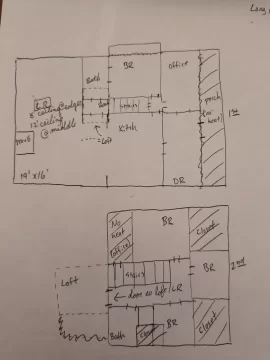Hello...I have been browsing the threads here for awhile for all manner of info from wood types, troubleshooting, and hearth builds. My husband and I are replacing our antique of a wood stove (the front said "Gatling" and it is basically a steel box with a hole) which was here when we moved in 2 years ago, and while reading other threads has been somewhat useful in narrowing our choices, I think advice for our specific scenario would be most helpful in picking a new stove. About the time we think we know what we want, more options seem to come up and we are at a little bit of a standstill. We like to use the stove for heat as much as possible, but do have a propane furnace as well.
Stove is located in the main living area on the first floor of a 2-story home (built 1920, addition ~1988). LR is a single-story addition with a 3x3 opening in the loft which can help get air into the 2nd story bedrooms. As best I can figure the square footage we would like to heat is about 2000sqft, about 700sqft in the 2nd story. The office and lower story BR are less of a priority to heat, but the more the better; experience and some common sense have shown these are the hardest areas to get warm air into anyway. Attached is a rough layout of the home for reference; definitely not quite to scale, hopefully it makes sense.

The wood we use is mostly medium to hard woods available to pick up locally, so far mainly ash, maple, and oak. We source, cut, and split it ourselves, sun-curing in stacks. Keeping ahead on getting it split and stacked has been a challenge, so while we're not burning green wood, it's not always perfectly dried out either. I anticipate this will continue to be the case, with hopes of allowing future wood to season better and better.
We are leaning towards a non-cat stove due to the less-than-ideal seasoning of our wood and wanting to avoid the ongoing cost of catalytic replacement over the years...but we could be convinced of a catalytic option. Looking for a stove that will keep the bedrooms warm-ish (which to us is around 60*) overnight and requires minimal babysitting/refills during the day (we had enough of that with our old stove, lol). Nice flames are a bonus.
Top choices (all available locally):
QuadraFire 4300 step-top, or Millenium 3100
PE Alderlea (T5 or T6???)
PE Summit
BK Princess (I guess the only cat stove in our top choices...is it as good as I've heard about to make it more worthwhile than the non-cat stoves?)
What are the differences in burn options between the different non-cat stoves? Specifically wondering about the baffle system in the PE stoves - how well does it work compared to other burn systems? Do the baffles ever need replacing?
What experience do people have with keeping the glass clean on any of these stoves?
Also seeking size recommendations for our home based on above information (and other info I can offer if needed). We are in Iowa with average winter high/low of 32*/16* and also want to use the stove outside the depths of winter without making the house unbearably hot.
Thank you!
Stove is located in the main living area on the first floor of a 2-story home (built 1920, addition ~1988). LR is a single-story addition with a 3x3 opening in the loft which can help get air into the 2nd story bedrooms. As best I can figure the square footage we would like to heat is about 2000sqft, about 700sqft in the 2nd story. The office and lower story BR are less of a priority to heat, but the more the better; experience and some common sense have shown these are the hardest areas to get warm air into anyway. Attached is a rough layout of the home for reference; definitely not quite to scale, hopefully it makes sense.

The wood we use is mostly medium to hard woods available to pick up locally, so far mainly ash, maple, and oak. We source, cut, and split it ourselves, sun-curing in stacks. Keeping ahead on getting it split and stacked has been a challenge, so while we're not burning green wood, it's not always perfectly dried out either. I anticipate this will continue to be the case, with hopes of allowing future wood to season better and better.
We are leaning towards a non-cat stove due to the less-than-ideal seasoning of our wood and wanting to avoid the ongoing cost of catalytic replacement over the years...but we could be convinced of a catalytic option. Looking for a stove that will keep the bedrooms warm-ish (which to us is around 60*) overnight and requires minimal babysitting/refills during the day (we had enough of that with our old stove, lol). Nice flames are a bonus.
Top choices (all available locally):
QuadraFire 4300 step-top, or Millenium 3100
PE Alderlea (T5 or T6???)
PE Summit
BK Princess (I guess the only cat stove in our top choices...is it as good as I've heard about to make it more worthwhile than the non-cat stoves?)
What are the differences in burn options between the different non-cat stoves? Specifically wondering about the baffle system in the PE stoves - how well does it work compared to other burn systems? Do the baffles ever need replacing?
What experience do people have with keeping the glass clean on any of these stoves?
Also seeking size recommendations for our home based on above information (and other info I can offer if needed). We are in Iowa with average winter high/low of 32*/16* and also want to use the stove outside the depths of winter without making the house unbearably hot.
Thank you!

